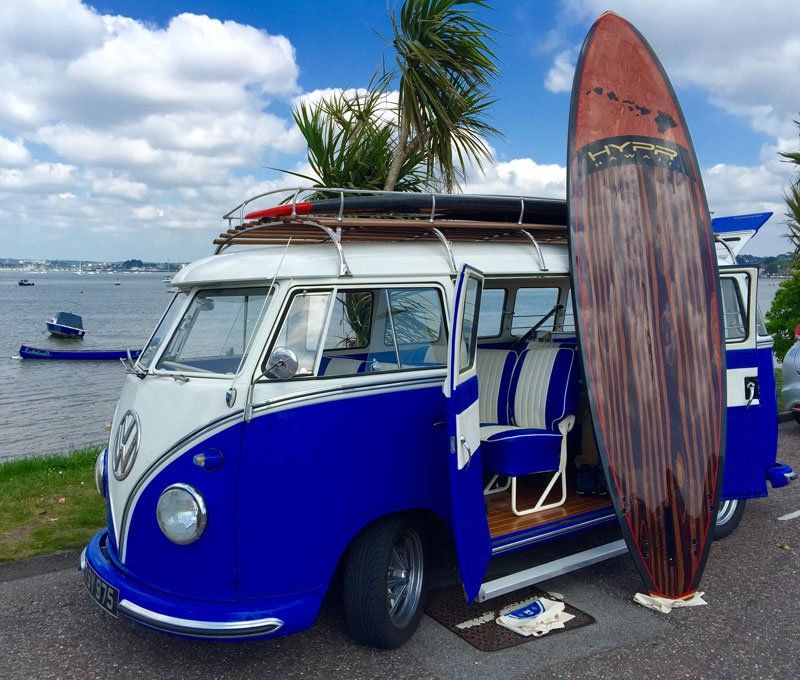Dirt, sand, and especially salt water may damage the board. Wash off the board after use with fresh water. You can also opt for a mixture of fresh water with light detergent. Lubricate metal parts on the board with WD-40 or a basic household oil - do this at the beginning of the season, and once at the end before storing to prevent rust and corrosion.
Direct exposure to intense sunlight over both short and long term periods can cause heat and UV rays to damage the board. The foam core of the board holds gas and air that can overheat, expand, and put pressure on the outer skin, potentially creating bubbles or cracks on the exterior. Some general tips for sun protection:
- Store in your HYPR board bag, as it has a reflective material that will protect your SUP when it’s exposed to strong UV rays.
- Use an elastic-trimmed board cover that covers only one side and lets the other side breathe.
- UV protective spray can also be occasionally sprayed on the board once or twice a year.
- When you’re not paddling in the sunshine, keep the board in the shade.
HYPR SUPs are so damn gorgeous that many paddlers store them indoors in high profile locations during the off-season. This is why HYPR’s foil design was named the ‘coffee table.’ Indoor storage is great as it’s free from exposure to the natural elements of the outdoors. Whatever the location, make sure the HYPR board is stored out of the sun at a temperature range of 4oC to 44oC. A mounted or suspended storage rack in the garage is a great way to store your SUP for frequent use, as it allows easy transfer from storage to the roof rack of your vehicle. Avoid storing objects on top of, or around the board as the extra pressure could possibly cause pressure dents and concave indentations on the outer shell.
Roof racks are best for transporting your board by vehicle. On the padded crossbars, place the board face down with the fin at front of the vehicle. Twelve foot cam straps are best for securely strapping down the board to each padded cross bar. Don’t over-tighten the straps to the point where they could potentially deform the board or create indentations. Consider a specialty lock designed specifically for SUPs on roof racks
-Fin tools: hex key (2.5mm) to attach remove the thruster fins & multi-screwdriver (with phillips #2 +) for the main fin
-16mm socket wrench for vent cap
-Spray lubricant such as WD-40 for protecting metal parts
-Hand brush to wipe off loose debris, sand or dirt
1. Lightly sand the affected area
2. Fill the dent cavity with epoxy resin and allow it to cure with the SUP positioned to minimize drips/flows of resin
3. After resin has dried and cured, lightly sand the affected area to remove any mounds of resin
4. Apply a clear coat spray to affected area
It's important to have your full carbon paddle cut to the right length for optimal paddling performance. HYPR Canada will do this for you once we know your height, type of paddling, and overall preference.
HYPR boards have a Gore-tex vent valve which allows air transfer between inside of board and the atmosphere, but prevents water getting inside. Make sure the cap is on and tight when paddling. The cap can be removed with a 16 mm socket wrench. There is no need to remove this cap at all, unless it is the off-season, or you are inspecting the O-ring for signs of wear.
Most HYPR boards have one large main fin, and two smaller side fins called thrusters. Thruster fins are installed with the included hex key (allen key - 2.5 mm or 3/32”), with flat side should be facing the main fin. Do not overtighten the thruster fin screws. It is possible the fin slot at the base of the fin may need to be sanded down a little bit to fit into the fin slot on the board; hand sanding is OK, but a belt sander works very well.
There are a few key pieces of equipment that are necessary by law in Canada while paddling and one we think that every paddler should have. Transport Canada understands stand up paddle boards as human powered vessels when they are being used for navigation. This would make them fall under the same guidelines as a canoe or kayak. What does this mean exactly? Well, when undertaking a trip or circuit such as a group crossing or solo outing, this is considered navigation, and you are subject to have a Canadian coast guard approved PFD (Inflatable Belt Pack), sounds signalling device (Whistle), and 15 meters of floating rope. There is a exception when being used within the surf zone for surfing activities... these requirements are not in force. Without these 3 pieces of equipment (except if you are surfing in a surf zone) you could face a fine if asked to produce such items by law enforcement. If travelling before sunrise or after sunset a navigation light is also required.



